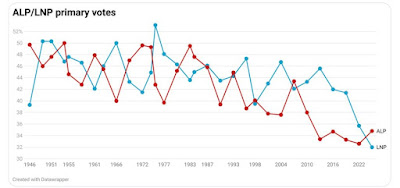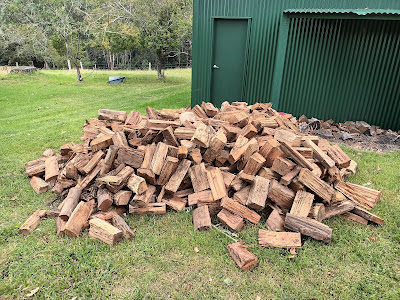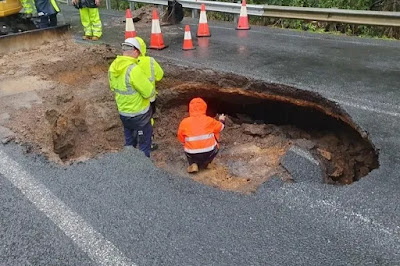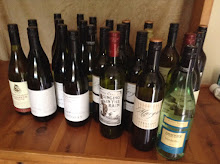Tuesday, July 01, 2025
Low Sugar Jam
Sunday, June 15, 2025
The Price of a Cafe Coffee v DIY
Next, there's the milk. A regular flat white typically uses around 200ml of milk. If you're paying $4.00 for a 2-litre bottle, that's $2.00 per litre, making the milk cost about 40 cents per cup.
Additionally there’s the cup and lid, which usually cost around 20 cents together.
Labour is one of the most significant costs in making a cup of coffee.
Consider a full-time, permanent barista working an 8-hour shift from 6 am to 2 pm. The award hourly rate is $27.17.
Adding in superannuation (401k) at 11%, holiday pay at 7%, sick pay at 3%, and workers' compensation at 3%, the total cost to the business per hour is $33.75, or $270 for the entire shift.
If a barista can make 200 coffees during this shift, the labour cost per cup is $1.35.
However, this cost can increase on weekends, reaching around $40 per hour on Saturdays and $50 per hour on Sundays. Therefore, how much it costs to make a cup of coffee can vary significantly based on the day and the number of cups sold.
The gross profit from a cup of coffee involves subtracting the ingredient and labour costs from the selling price.
Assuming a flat white sells for $5.00.
First remove the 10% GST (goods and services tax) which is 45 cents, leaving $4.55.
Deduction of the 98 cents ingredient and $1.35 labour costs leaves final gross profit per cup is $2.22.
Out of that the café then has to pay for rent, power, insurance, and other operational costs like cleaning and garbage disposal. These costs can add up per week. The combination of profit from the coffee and other items sold at the café all have to contribute to covering these expenses.
Monday, May 12, 2025
Australian Federal Election 2025 (2nd July Update)
Voting is compulsory.
Voting was for the entire House of Representatives (lower house) 150 seats, and one half of the Senate’s (upper house) state representatives and all four territory representatives.
The Senate is a state house of review with state Senators enjoying a six year tenure and territory representatives’ tenure tied to the term of the lower house.
There are a total of 76 senators: twelve are elected from each of the six states regardless of population, and two each from the two territories.
The main contenders for government were the current incumbents, the Australian Labor Party (democratic socialists) and the opposition Liberal National Party (a coalition of urban and rural conservatives*).
There were also a large number of minor parties (30!) eg. The Greens, One Nation plus others and Independents contesting.
It is interesting note how Australia has voted ideologically since 1946.
This time around it was a landslide victory for the Labor Party led by Prime Minister Anthony Albanese.
They won an increased number of seats.
 |
| PM Anthony Albanese |
The conservatives have been decimated.
The LNP opposition leader, Peter Dutton lost the seat he had held for 24 years.
Up until early March polls showed a certain LNP victory.
What happened?
Prior to the 2024 USA election, 73% of Australians surveyed preferred a Democrat presidential victory.
When the USA imposed tariffs on Australian imports despite a trade balance in the former’s favour in April our Prime Minister labelled the US actions as ‘unwarranted’, and ‘not the act of a friend’.
The majority of the population agreed with him.
However Dutton said that if elected he would cut public sector jobs - more than 40,000 by some estimates. This reminded voters of billionaire Elon Musk's DOGE, or Department of Government Efficiency, which has slashed US bureaucracy.
Dutton later walked back the plan but it was too late.
The Coalition even appointed a shadow minister for government efficiency. And images of her wearing a cap with the words MAGA became a key talking point.
Dutton also said Donald Trump is a "big thinker and a deal maker" with a "genuine desire to see peace and stability" in the Middle East after Trump had proposed to "level" the enclave and rebuild a "riviera" under American control.
Shadow attorney-general Michaelia Cash praised Trump as “a man of action”, promising Australians “they’ll get the exact same attitude under a Peter Dutton government”.
Chris LaCivita, Trump’s presidential campaign co-manager, told undercover reporters he advised on ‘structural issues’ related to Peter Dutton.
However the Coalition denied LaCivita was involved in campaign in any way.
But there were other major factors as well.
The Coalition’s nuclear energy policy was toxic to voters, delivering big swings against their candidates in electorates chosen to host reactors, while support for Labor grew in many places it chose for massive offshore wind farms.
It was hoped the LNP would tailor some policies towards women. It was clear it wasn’t a priority.
The policy and messaging on work from home and the failure to acknowledge how hard women’s lives already are, without lumping them with more, was nothing short of disgraceful.
It brazenly highlighted that the party was still disconnected from the everyday lives of women.
Housing affordability has long been a priority issue for voters at federal elections, but as the “great Australian dream” of homeownership slips out of reach, both sides amplified their property policies.
Most economists were cynical about the measures, saying these will simply increase demand for housing in a market where the supply of new homes is constrained because of government regulation and the high cost of construction.
The expected result of both party policies?
Higher house prices and more risky debt levels.
The LNP went to the election with an economic policy of tax rises and two years of bigger budget deficits, built on a guarantee that the economy would instantly improve merely because they would running the show.
Most voters treated this flimsy assertion as a joke.
On defence, it pledged to spend more but could not nominate on what.
The cost of living crises was met with similar shady policies.
In the final weeks of the campaign, the opposition doubled down on stoking fear and division, reviving culture-war rhetoric, attacking diversity initiatives, and once again turning Aboriginal people into political targets.
And of course there was Dutton himself.
The opposition leader was well known for his "tough guy" persona, developed off the back of years as a police officer and later as immigration and home affairs minister.
 |
| Peter Dutton |
In the end it was all more than the electorate could bear and it responded accordingly.
Nearly five million Senate ballot papers have been received at state-based Central Senate Scrutiny sites now and this is where the process of capturing and validating the hundreds of millions of Senate preferences occurs.
While some Senate positions are known now, the full Senate count is always a reasonably lengthy process with final positions not known until the full distribution of preferences some weeks after election day.
A total of 39 votes is needed to pass laws in the Senate, meaning Labor can ensure passage of bills with the support of just the Greens or the Coalition.
Nationals leader David Littleproud has sensationally announced that his party has split with the Liberal Party for the next term of federal parliament.
Littleproud spoke in Canberra on Tuesday morning after he and new Liberal leader Sussan Ley held discussions over the past week to try to come to terms, but were unable to do so.
The Liberal and National parties are inching towards reforming the Coalition after Liberal MPs gave their leader Sussan Ley in-principle agreement for most of David Littleproud’s policy demands, but speculation is growing about Littleproud’s future as leader of the regional party. Ley convened a party room meeting on Friday afternoon at which her MPs gave their leader the authority to strike a deal with the Nationals to create a joint shadow cabinet
by the time parliament resumes, days after Littleproud sparked chaos by splitting from the Liberals.
Update: 28/05/2025: Liberal and National Parties Reunite.
The Coalition is officially back together after Liberal leader Sussan Ley and Nationals leader David Littleproud struck an agreement to reunite. They both have announced their combined shadow ministry.
What a circus!
Update 10/06/2025: Battle for the Last Seat
Teal candidate Nicolette Boele has seized the once blue-ribbon north shore seat of Bradfield after a recount, beating Liberal hopeful Gisele Kapterian by just 26 votes in one of the tightest elections in history.
Boele’s win will mark the first time in 75 years that the seat is not held by the Liberals but despite the Australian Electoral Commission declaring Boele the winner, Kapterian has not conceded and has indicated she would consider taking the result to court. The Liberal Party’s NSW branch will have until 40 days after the Australian Electoral Commission (AEC) returns the writs to do this ie.before 9th July.
Update 02/07/2025: Liberals Considering to Challenge Bradfield Seat Result
NSW Liberal members want party bosses to fund a court challenge and indemnify Bradfield candidate Gisele Kapterian in a bid to have her failed election result overturned and prompt a byelection in the country’s most marginal seat. However, there is increasing concern from some within the Liberals that a court challenge would be a risk financially and politically for a party trying to recover from a devastating federal election loss which reduced its seat count in NSW to six. Polling also shows successful teal candidate Nicolette Boele would increase her primary vote if Bradfield voters were forced back to the polls in a byelection.
Friday, April 25, 2025
Anzac Day 2025
Wednesday, April 16, 2025
Bushfire Hazard Reduction / Burn Piles
Wednesday, March 26, 2025
Winter Firewood Delivery
Thursday, February 27, 2025
The Currowan Fire / Five Year Anniversary
The fire started on November 25, 2019 from a lightning strike and went on to kill three people, destroy hundreds of homes and burn through 500,000 hectares (1.25million acres).
People lived with the threat of this fire until mid February 2020.
We were evacuated for a week but our home was saved due to the bravery of the men and women of the NSW Rural Fire Service with flames coming to within a meter of our house. We lost fences, a machine shed and all our beautiful bushland, since mostly recovered.
The smell of smoke still haunts us and our neighbours today.
Sunday, January 26, 2025
Australia Day 2025
We take no part of any celebration of this day in solidarity with our indigenous population.
Monday, January 20, 2025
Chronic Inflammatory Demyelinating Polyneuropathy
CIDP can occur at any age and in both sexes, but is more common in men than women.
Symptoms include tingling, numbness or altered feeling which often begins in the feet and hands, weakness of the arms and legs, fatigue and aching pain in the muscles.
Because CIDP is rare, it’s often hard to correctly diagnose the disease, at least at first.
-A nerve conduction study and an electromyogram to look for myelin damage in peripheral nerves. This involves using mild electrical currents to test nerve and muscle function and response.
-A lumbar puncture to see if levels of certain proteins related to the disease are higher than normal.
-A nerve biopsy to look at microscopic changes in the nerves. This test is rarely done.
-MRI may show inflammation of the nerve roots. The roots are the part of the nerve where it branches off from the spinal cord.
Some may have a bout of CIDP followed by spontaneous recovery, while others may have many bouts with partial recovery in between relapses.
Tuesday, January 14, 2025
The Sound of an Australian Summer / Cicadas
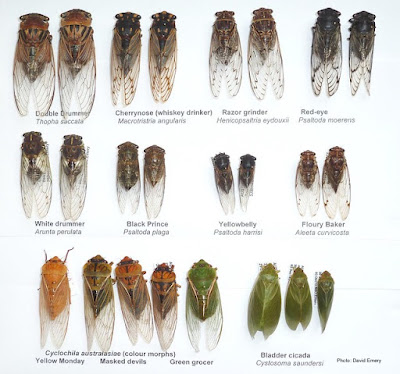 |
| Some Australian Cicadas |
Sunday, January 05, 2025
Australia’s Christmas Beetles
At least 10 species occur in the Sydney region, more if the Blue Mountains west of the city are included.
They are also found in forests and woodlands in other parts of southern and eastern Australia.
Anoplognathus viriditarsis is the largest of the Sydney Christmas beetles.
They have vibrant colours and the adults emerge close to the Christmas period.
In the past adults occurred in large numbers, sometimes completely defoliating trees.
But where have they gone?
I didn’t see one this year or in recent years for that matter.
It has been reported that total number of Christmas Beetles in the Sydney area has declined over the last 3 decades as the grassy woodland areas get used up for housing.
Sadly a sign of the times for our native wildlife inhabitants.
Wednesday, January 01, 2025
Wednesday, December 25, 2024
Saturday, December 21, 2024
The Longest Day of the Year
So today Australia will bask in between 13 and 15 hours of daylight depending where you live.
Brisbane: 4.49am – 6.42pm (13 hrs 52 mins)
Canberra: 5.45am – 8.17pm (14 hrs 32 mins)
Darwin: 6.18am – 7.10pm (12 hrs 51 mins)
Hobart: 5.28am – 8.49pm (15 hrs 21 mins)
Melbourne: 5.54am – 8.41pm (14 hrs 47 mins)
Perth: 5.06am – 7.21pm (14 hrs, 14 mins)
Sydney: 5.40am – 8.05pm (14 hrs 24 mins)
Wednesday, November 13, 2024
Our City Council Is Broke.
Regional councils have borne the brunt of natural disasters such as bushfires, storms and floods over the past five financial years, figures show, with Shoalhaven and neighbouring Wingecarribee Shire recording 14 disasters each, on top of the pandemic – more than any other council in the state.
The emergencies that hit the Shoalhaven include the Black Summer bushfires that burnt almost 70 per cent of the area, and more than a dozen storms that washed away roads and caused landslides.
The most recent disaster was a severe storm with torrential rain in June, which caused a giant pothole to appear in a major arterial route near Jervis Bay, disrupting travel for thousands of people. It took months to repair.
The NSW government has issued 85 natural disaster declarations since 2019-20. These allow councils to seek emergency state funding for repairs but Shoalhaven council chief executive said the council also had to chip in about $600,000 each time.
“If [another] natural disaster were to occur, council would not have the available cash to respond,” she said in her report to councillors before last week’s meeting, noting cash reserves had fallen from $19 million five years ago to zero in June.
The Shoalhaven council had lost almost $15 million to disasters since 2019, including through subsidies and fee waivers related to the pandemic, and faced a budget black hole of up to $35 million that could only be addressed through a special rate variation.
Last week, councillors put the option of an 8 or 12 per cent rate rise to the community for feedback.
The previous council refused to support a staff push for a 32 per cent rate rise in January that would have restored the council’s finances.
I calculated what a 12% rate increase would mean for us.
Over the year it would be less than the cost of a new tyre and wheel damaged by the appalling condition of our potholed rural roads.
But obviously many residents are already struggling with the cost of living crisis and don’t need added financial stress.
Source: Sydney Morning Herald.
Friday, October 18, 2024
A Trip to Brisbane
It was originally almost entirely industrial then was redeveloped as the site for World Expo 88
We walked through the tropical gardens and visited the Queensland Art Gallery and Gallery of Modern Art, fitting in a morning coffee and an excellent midday lunch.
The weather wasn’t the best, cool and windy, but thankfully the rain held off.
The city skyline is impressive.
The new owners had built another storey on top. It looked quite out of proportion as a result.
Then we caught up with an old school friend at a local cafe for brunch before heading into New Farm and its beautiful park. The jacaranda trees were in full bloom.
That evening we ventured to one of our mutual old haunts, the Breakfast Creek Hotel (the Brekky Creek) and the Spanish Garden steak house.
The steaks were as good as ever.
Next morning we were up early for our flight home.
Brisbane airport was very busy. Forty minutes in the bag drop line.
Then the four hour drive home.
A great few days.
Thanks Pammy.
Sunday, October 13, 2024
Hibbertia scandens / An Acceptable Weed
It is a vigorous climber with stems reaching up to five metres in length as well as a ground cover.
It is found mainly in coastal areas in NSW, extending into the northern tablelands and a little into the central tablelands. It grows along the entire NSW Coast and most of the Queensland coast as far north as Cape York.
It also grows in the far north-east of Victoria.
Its habitats are coastal dune forest, wet sclerophyll woodlands and forests and well as coastal scrub and heathlands growing on sandy soils.
The plant produce fruit as follicles. In this species, they are about 2 cm long, ripening to red-brown.
In our local plant nursery it’s commonly known as the Guinea Flower.




